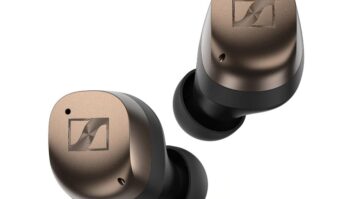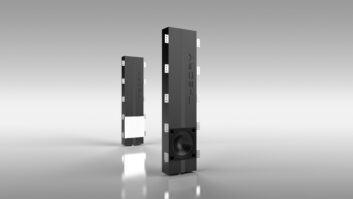LAS VEGAS — Rock legend Neil Young went to International CES last month to highlight the recently shipping Pono high-resolution music player and the Pono Music World download site.
Young sat down with TWICE to answer a few questions about Pono, the process behind it and what lies ahead.
TWICE: Someone on your team said Pono has been about a seven-year process from inception to product. Does that sound about right?
Young: Yeah, it’s been a long time. It’s hard to say when it started to where we are now. But I think it’s like somewhere around 10 years. Around the turn of the century, that’s when we started working on it.
Marc Benioff [Salesforce CEO] and I spent a lot of time talking about it in Hawaii, which is one of the reasons why it’s called Pono—that’s a Hawaiian name. I kept saying to him, we gotta figure out a way to get things to sound good. I know I make them sound good by playing them on something I know sounds good, but their contraptions are very difficult to get to, and nobody can use them. They didn’t go in the direction they could have with Blu-ray and DVD-Audio, and they didn’t make it portable and small and easy. They made a lot of mistakes—they being everybody who decided to make DVD-A into something bigger, 5.1 or whatever it was. It became so cumbersome that no one wanted it. Housewives hated it. It was bad furniture.
Neil Young
TWICE: Big giant black boxes, cables everywhere.
Young: Yeah, nobody wants that. So they didn’t have a stereo version of it. So there was a lost opportunity to just go to a better-sounding disc.
Our machine is the mother of all formats. We’re not locked into anything. We’ll play anything you put into it. We’re making our technology diagrams and road maps available for people to use, and if they want to submit them to us, and we see what they did, we’ll certify them if they did it right. They can use it if they didn’t do it right, but it won’t be Pono certified. That way we’re not holding anybody back. We’re letting everybody do what they want to do. We don’t want to be restrictive. We just want to raise the bar for music listening and make it available for anyone who wants to hear it. Some people think they don’t need it, and that’s OK.
TWICE: Why did you decide to go with Kickstarter as the launchpad?
Young: Well, we were out of money. (laughs) There are only five people in the company.
TWICE: You didn’t want to go to private equity companies?
Young: Oh, we went there. Nobody’s interested.
TWICE: You were ahead of the curve. The industry has kind of caught up with you now.
Young: High-res is now starting to get people’s attention. And now Pono kind of means high-res audio, and that’s good. We want people to understand there’s a quality thing behind Pono. Not only do we play it back right, but we supply the music. We have contacts with all the record companies, and we have the best that they have. And we’re constantly improving that. We’re pushing them, and we’re also going in through the artists. If the artists ask for it, the record companies want to give it to them. The record companies want to be able to support the artist, which is something the tech companies didn’t really want to do.
TWICE: What about contemporary artists who produce much of their sounds through machines rather than instruments? Are they as concerned about reproduction?
Young: Depends what they do. You take some of these bands who record in really low res, and it’s a new window. If you record in low res, maybe you want to use high res as effect. Maybe you want your chorus or your hook to be in 92, but the whole rest of the song in 44.1. Resolution is part of the musical palette.
TWICE: Are you worried about the devices people are going to use with the player? That the quality will be lost?
Young: No, that’s a choice they make. Like when we had record players, you used to play them through cheap little record players or a big one. It was still a record. The source is what matters. What you use choose to play it through, or what you can afford to use, is your choice. However, I caution people to be aware that some of the devices out there will resample an analog signal. We put out an analog signal and it’s already been prepared to listen to. … That part of it is compromised and destroyed by certain components that are out there now.
If you plug an analog signal into something and it resamples it down to 44.1, and it’s a cheap shitty 44.1 sampler, then you’ve lost your Pono sound. Although it will sound better than anything else you stuck in there because the source was good when it went in, and it’s going to sample a really good source at a lower resolution, so it will sound better than sampling a bad source. So it’s still better, but you don’t get the full bang. So the thing is, because of the MP3 generation, people have dummied down their playbacks because of the manufacturers. I know you’ve noticed they stopped selling big speakers. Everything is [small and portable] because you can’t play an MP3 back in anything big because it sounds so terrible. But now Best Buy and all of the audio places can now produce [big speakers], big systems, and you can listen to Pono on them, and crank it up and it sounds like God.
We’ve taken the limitation away. I think once people realize this, Best Buy and these places will be selling all of their Magnolia equipment and all of their stereo equipment by playing Pono through it.
That’s the deal with Harman in cars. They have great speaker systems. They have made Clari-Fi, which cleans up and improves MP3s. But what this does at the very beginning of Clari-Fi, it recognizes if something is better than it needs to be and something that needs to be improved and makes a decision right there whether it’s going to use Clari-Fi technology or not. Now you can recognize if it’s a Pono signal, then just bypass the entire thing and go to a Pono-certified amplifier on the other end, and you’ll have what you need to have. So systems are capable of being designed to bypass the things that have been made to make MP3s sound OK. It’s a fruitless endeavor, but still they try.
TWICE: Do you see endorsements or licensing arrangements for speakers or equipment?
Young: Speakers can be branded Pono. Anything that’s clean, anything that’s capable of playing back the signal, can be branded.
TWICE: Any plans for subscription services?
Young: That would be something we’ll get to down the road. We’re thinking about it. We’re thinking if the technology comes along that can stream.
TWICE: You mentioned that one day the iPhone would be able to control the Pono player. What did you mean by that?
Young: Yes, with an app. So you wouldn’t have to have two devices; you’re always using one device. … We’ll build an app so you only have to have one device to do things with. This first-generation player is a demonstration of what we can do. What the sound is. We’re not trying to do anything else but show people what great sound sounds like. That’s it. It’s a singlepurpose device.
TWICE: Someone on your team mentioned your discussions with Steve Jobs early on to try to get Apple’s involvement. Was he open to this?
Young: He was a consumer-orientated person. So when he said to me, “Neil, give me your files, and I’ll have my guys work on them, and we’ll see what we can do,” I said that wasn’t going to work. You’ve got to change your hardware. You can’t play it back through the DAC in the iPod. You won’t hear it. And he said, “Well, we’re a consumer company. That’s the difference.” And I said I remember when consumers used to have great quality. They were consumers. They bought records.
TWICE: Do you consider Pono a consumer company?
Young: Yes. I do. I consider Pono a mainstream consumer company. Not an audiophile product. I don’t view the audiophile market as a target. I view the music- loving market as a target.
TWICE: In terms of getting the product out there, would you be opposed to a mass market retailer?
Young: We’re not opposed to anything. Anything that gets the music to the people, that’s our goal. We only have one goal: raise the bar of music. If we intimidate a huge company into coming along and doing what we’re doing, we’ve scored. We’re not in there for anything else. And we’ll still be there because we were the first and people will relate to that. They’ll relate to it for as long as we want to do it.
TWICE: What has been the biggest challenge?
Young: Raising money. But now we have a little bit of a buzz going. People are starting to realize that it’s real, that four or five guys built a downloading service like iTunes, that actually sounds better and some people think is better, and we built a player that definitely sounds better. And we have a complete library of highres – over 2 million tracks and growing every second. It’s all happening. It’s not a pie in the sky thing.
TWICE: Why isn’t this a company of recording artists — friends, peers, etc.?
Young: We have investors who are recording artists. We don’t brag about them. They just want it, but they don’t want their business to be known. But there are major recording artists invested in Pono.













